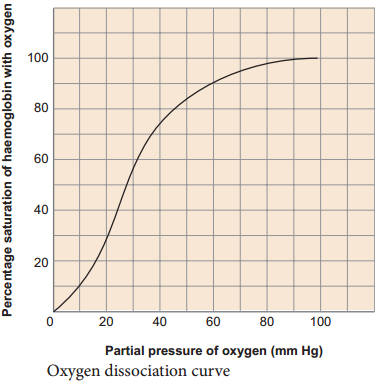Learninsta presents the core concepts of Biology with high-quality research papers and topical review articles.
Transport of Various Types of Respiratory Gases
Transport of Oxygen
Molecular oxygen is carried in blood in two ways bound to haemoglobin within the red blood cells and dissolved in plasma. Oxygen is poorly soluble in water, so only 3% of the oxygen is transported in the dissolved form. 97% of oxygen binds with haemoglobin in a reversible manner to form oxyhaemoglobin (HbO2).
The rate at which haemoglobin binds with O2 is regulated by the partial pressure of O2. Each haemoglobin
carries maximum of four molecules of oxygen. In the alveoli high pO2, low pCO2, low temperature and less H+ concentration, favours the formation of oxyhaemoglobin, whereas in the tissues low pO2, high pCO2, high H+ and high temperature favours the dissociation of oxygen from oxyhaemoglobin.

A sigmoid curve (S-shaped) is obtained when percentage saturation of haemoglobin with oxygen is plotted against pO2. This curve is called oxygenhaemoglobin dissociation curve (Figure 6.7). This S-shaped curve has a steep slope for pO2 values between 10 and 50mmHg and then flattens between 70 and 100 mm Hg. Under normal physiological conditions, every 100mL of oxygenated blood can deliver about 5mL of O2 to the tissues.
Transport of Carbon – Dioxide
Blood transports CO2 from the tissue cells to the lungs in three ways
(i) Dissolved in Plasma
About 7 – 10% of CO2 is transported in a dissolved form in the plasma.
(ii) Bound to Haemoglobin
About 20 – 25% of dissolved CO2 is bound and carried in the RBCs as carbaminohaemoglobin (Hb CO2)
CO2 ⇄ Hb Hb CO2
(iii) As Bicarbonate Ions in Plasma
About 70% of CO2 is transported as bicarbonate ions. This is influenced by pCO2 and the degree of haemoglobin oxygenation. RBCs contain a high concentration of the enzyme, carbonic anhydrase, whereas small amounts of carbonic anhydrase is present in the plasma.
At the tissues the pCO2 is high due to catabolism and diffuses into the blood to form HCO3– and H+ ions. When CO2 diffuses into the RBCs, it combines with water forming carbonic acid (H2CO3) catalyzed by carbonic anhydrase. Carbonic acid is unstable and dissociates into hydrogen and bicarbonate ions. Carbonic anhydrase facilitates the reaction in both directions.

The HCO3– moves quickly from the RBCs into the plasma, where it is carried to the lungs. At the alveolar site where pCO2 is low, the reaction is reversed leading to the formation of CO2 and water. Thus CO2 trapped as HCO3– at the tissue level it is transported to the alveoli and released out as CO2. Every 100mL of deoxygenated blood delivers 4mL of CO2 to the alveoli for elimination.